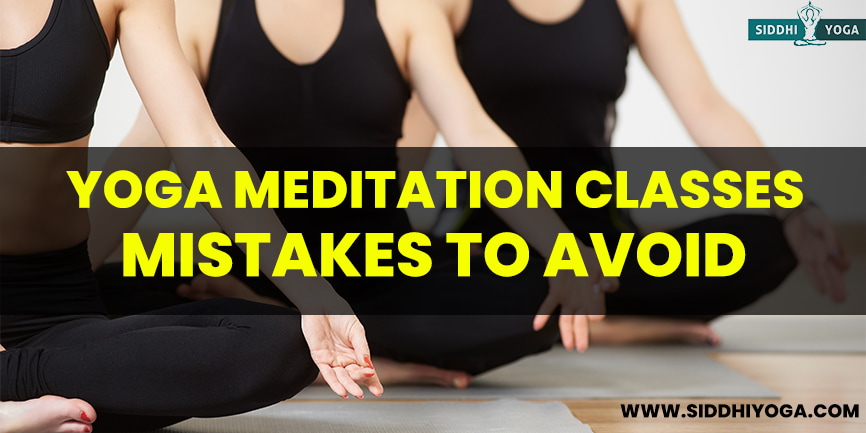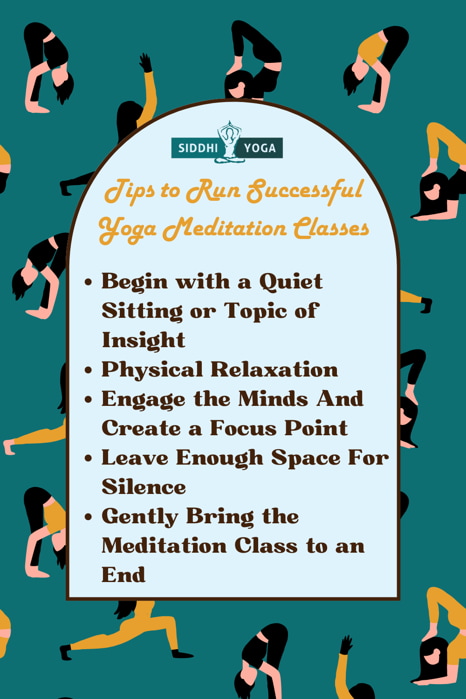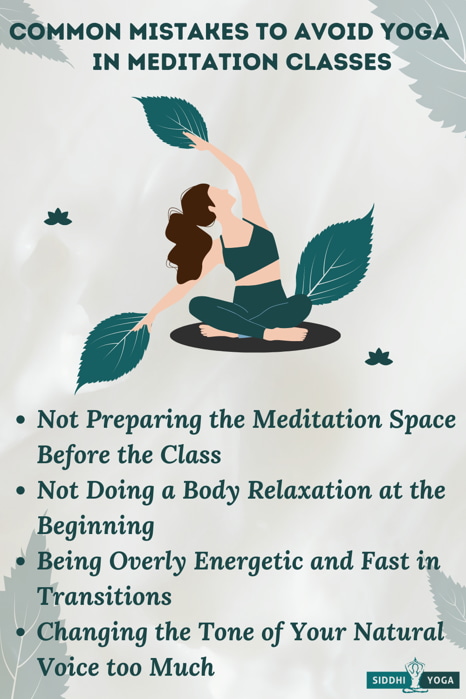
This article will teach us how to conduct a yoga meditation class without making common mistakes.
Introduction
Meditation is one of the eight Limbs of Ashtanga yoga, coming after the yamas (abstinences), niyamas (observances), asanas (poses), pranayama (breath and energy control), pratyahara (withdrawal of senses), Dharana (concentration). The meditative state is a practice that moves away from our physical recognition of the world and ourselves, leading towards a higher source of energy and knowledge called Samadhi, or union with the Divinity.
The limbs of Ashtanga Yoga are part of the preparation practice before meditation. In traditional yogic teachings, they are crucial to explore for anyone delving seriously into their meditation journey.
Can Meditation be Taught
Some people know yoga only for the asanas, poses, and sequences, but more and more, the necessity of our rushed times has been pointing our focus toward meditation. Meditation has been practiced for centuries and is rooted in Hinduism and Buddhist traditions. Thanks to teachers passing on their knowledge and experiences of yoga, meditation has become a part of our daily yogic practice.
Like any new skill, meditation can be taught and practiced, like writing or reading. Even though we all learned how to write using the same set of letters, sitting with all our classmates in the same room, we still developed our unique handwriting. A similar thing happens when it comes to meditation. We can all use specific techniques and practices, like yoga asana sequences or pranayama, to learn how to focus and delve deeper into meditative states. Still, each of us will experience his or her unique meditation. There is no right or wrong when practicing meditation, so there is not just one way to do it.
We can gain knowledge from more experienced teachers and meditation guides, follow guided meditation, read and learn from meditation literature and practice our own lives meditation just as we wish to.
Teaching meditation is very much like teaching art or music. It is a very personal and intimate practice where much freedom and intuition should come into play. Every meditation class– is different; how it turns out depends on the energy and experience of the people taking part. A student needs more firm and structured meditation classes at the beginning of learning how to meditate. Later on, as he progresses, the student should allow his intuition and creativity more room for expression.
Tips to Run Successful Yoga Meditation Classes
Preparing and leading a meditation class can be a very profound experience. When new students come to a meditation practice, they often feel overwhelmed with emotions, thoughts, insecurities, and doubts. Those feelings are understandable and are also a part of everyone’s journey through yoga and meditation.
A skilled teacher can prepare a safe, comfortable, and relaxing space where all those fears will be gradually transformed into a deep meditative state.

Below you will find some helpful tips on how to prepare and run a successful yoga meditation class:
Begin with a Quiet Sitting or Topic of Insight
Starting a guided meditation with quiet sitting and conscious breathwork is a great way to welcome everyone into the meditation space. This gentle and soft approach allows each student’s energy to flow freely without intervening too much with its natural flow. Inviting everyone to be can create an open and wide meditation space to add on guided meditation then gradually.
Suppose you want to start a meditation class with a more verbal approach. In that case, you may try going for an open discussion or speech – taking one of the yamas and niyamas (moral guidelines Ashtanga Yoga) as a focal point, for example. A short story, quote, or poem can also be a creative and insightful way of inviting the group to feel specific energy together in a shared space.
Physical Relaxation
A very important aspect of leading a meditation class is bringing the students to a state of relaxation. Our physical bodies require time and space to feel comfortable and safe. It is good to guide a conscious pranayama rhythmic breathing to initiate the first state of relaxation – the heartbeat.
For a beginner’s class, it is recommended to guide a 4×4 or 6×6 Sukha Purvaka Pranayama, also known as easy breathing. If the class is more familiar with meditation and breathing techniques, you may go through a Sama Vritti Pranayama, also known as box breathing.
After at least six to nine rounds of the previously mentioned pranayama, you may start to guide your class through a body scan and muscle relaxation, allowing the students to follow their natural breath or keep following the guided count. Muscle relaxation and leaving tensions behind are crucial in guiding a meditation class.
The amount of time needed to loosen up and let go of physical tensions will vary from person to person, which is completely fine. In a guided meditation class, time is usually limited, so it is important to have a frame for this part. This might take from five to fifteen minutes, depending on the duration of the whole class, and is best done in the meditative position.
Engage the Minds And Create A Focus Point
Creating a welcoming space within your students’ minds for them to explore is key to leading a well-structured meditation class. There are different ways to create meditative and introspective energy to lead your students to a more united and all-connective space.
Visualization combined with breathwork, posing thought-provoking questions, telling a short story, mantra invocation, and sound vibrations are just a few things you can do to guide your students through.
Choosing a focal point is also a very important aspect of meditation. For a beginner’s class, it is good to remind them about that focus point – whether it’s a mantra, a sound, a breath, or an emotion – to make sure they cultivate that space within themselves firmly enough to return to it whenever they need to. With a well-prepared center of awareness, the students can return to meditation whenever their thoughts drift away.
Leave Enough Space For Silence
Silence and peace are very special moments in yoga meditation classes. Allowing everyone to experience themselves in that specific moment is why the previous preparation takes place.
You may feel protective, caring, and emotional when guiding a yoga meditation class. But it is also important to be able to leave the space. Releasing any expectations and necessities within the class is a very profound moment, both for the teacher and the students.
Let the class know your voice will fade away, and the space will be left for everyone in silence. This way, the students can plunge more profoundly into the silence without waiting for further guidance from the teacher’s voice.
Gently Bring the Meditation Class to an End
When the time of the class is coming to an end, you may softly bring the sound back into the ambiance. It might be the sound of your voice and an inviting phrase to come back to the body, the sound of a singing bowl, a mantra, or any other way you would like to regain your students’ attention.
This moment is very special and rich in personal sensations; it is, therefore, important to allow your class to notice and take in whatever they are feeling and experiencing. If there is silence, let there be silence. If thoughts are coming through, let them come. If physical sensations are coming around, let them be felt.
After this gentle awakening, it’s time to take your students through a re-engaging body practice. Starting with the lower body, invite them to wiggle the toes and feet, moving up towards the knees and hips, the torso, the arms and hands, the neck, and finally, the head and face. This body scan and gentle movement is a great way to bring the class back to body awareness.
Invite the students to move and stretch freely in any direction and manner. This is the space they can truly reconnect with how they feel and what they need in motion and physical movement. It feels good to them at this moment.
After some time, you may invite the class to sit comfortably in stillness again, if that feels comfortable, and guide their hands towards the face for a gentle massage. Next, it will be time to join hands together in Anjali Mudra – palms pressing together in front of the heart –or any gesture of gratitude they feel comfortable with, and slowly open their eyes and take deep, conscious breaths.
Thank the class for collectively creating the meditative space, and remind them to drink plenty of water throughout the day and take their time to rest longer if necessary. Rushing towards daily routines after an entire meditation class may be overwhelming, and listening to the body’s natural rhythm is good.
Common Mistakes to Avoid while Opening meditation for the yoga class

Not Preparing the Meditation Space Before the Class
It is important to give your students the experience of entering a quiet, clean, and well-ventilated space for their yoga class or meditation session. Practices that require stillness, such as meditation, also need a safe and peaceful space – especially for beginner classes. It is good to ensure the room or sala is ready before the students come in and take their seats.
If possible, leave an open window allowing fresh air to enter the room, and have a few plants in the room. It is important to have access to natural prana when preparing the space for a yoga or meditation class.
Not Doing a Body Relaxation at the Beginning
Preparing the body to enter a relaxed and meditative space is a step that should never be skipped. Remember to incorporate any physical loosening and tension release before meditation, whether with a short yoga class beforehand, gentle Gattis and free movements, or a body scan.
Being Overly Energetic and Fast in Transitions
Preparing a guided meditation structure is one thing, and leading a class is an entirely different experience. Often at the beginning of meditation classes, the teacher might feel that there is not enough time to go through all the stages, which might lead to a nervous and fast way of speaking and breathing.
It is better to use a gentle tone of voice and speak slowly and calmly with a more basic structure rather than fly through the meditation to say everything we have planned.
Changing the Tone of Your Natural Voice too Much
To lead a guided meditation class, a kindly, gentle and soft voice is ideal. Generally, students are more receptive to instructions when given in a low, calming, and soft voice, but only if it is done with your natural voice and pitch. But not all of us have low, calming voices, so avoid „trying too hard.” If you find that a low, calming tone does not sound natural coming from you, then switch back to your natural voice. The students will pick up the honest and truthful energy your voice exudes. You are unique with your unique sound – please remember that when you use your voice in any practice and guidance.
The Bottomline
Whether you are teaching or planning to guide meditation classes, practice and go to other classes beforehand, learning from experience is the best way to discover our unique way of practicing and teaching. When preparing your next meditation class, remember to approach it with an open and kind heart, with a desire to give your students a new and fresh meditation experience, which they can later explore on their own. We invite you to join our online Calm Your Spirit, Sooth Your Mind meditation course to delve deeper into your practice and broaden your teaching skills.